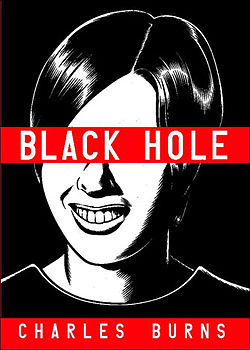 Donald Duck chops down a tree. Pluto goes for a swim at the beach. Most Disney shorts sound like absolutely nothing when you describe them. But when you see those bare vapours animated at 24 frames per second in bright Technicolor, something incredible happens. The Disney magic emerges, like a Golem shambling from mud (Walt wasn’t crazy about Jews, so a very goyish Golem). No piston does much on its own, but put four of them together and they move a car.
Donald Duck chops down a tree. Pluto goes for a swim at the beach. Most Disney shorts sound like absolutely nothing when you describe them. But when you see those bare vapours animated at 24 frames per second in bright Technicolor, something incredible happens. The Disney magic emerges, like a Golem shambling from mud (Walt wasn’t crazy about Jews, so a very goyish Golem). No piston does much on its own, but put four of them together and they move a car.
Kami no Kodomo “Child of God” is a manga that achieves extreme effects with simple ingredients: in this case, a simple Kafka-esque monologue from a serial killer. It was written and illustrated by Nishioka Kyoudai a brother-sister manga team who sometimes write as “Nishioka Brosis”.
This is pretty underground. Their art is so stylised it’s barely recognisable as manga: it looks like Klasky-Csupo mixed with Picasso and spliced with dangerous recessive genes from that “Worker and Parasite” short that was on the Simpsons. I think I will credit Nishioka Brosis as inventors of a new style: Worker and Parasite Manga.
The narrative a little confusing. At times it’s surrealist nonsense (the story begins with the protagonist being born from a woman’s asshole), at other times a cohesive and naturalistic plot unfolds. Kami no Kodomo is a little like ice at that critical moment when it starts to freeze: hard parts bobbing awkwardly in yielding water. I think this is an intentional effect, with parallels to Bret Easton Ellis’s America Psycho, where you start to wonder at the end whether the whole thing isn’t a bunch of crazy fantasies.
The main character grows up (I forget if he has a name), and goes to school. He’s pretty different. Is he even a he? The art style forces androgyny on everyone. Soon he gets to partake in a few crimes, both as onlooker and participant, and sort of falls into the habit of killing people. It’s like scratching an itch.
He attracts followers, all of which are sorta-maybe-pseudoboys, and they start their own little Manson family. There’s a homoerotic subtext at first, and soon it’s more of a supertext – tons of gay sex decorates the margins of the mass murders. The final few chapters of Kami no Kodomo are consumed by a tragic love arc worthy of a yaoi fanfic: I’d complain that it was out of place in the story, but that would require me to specify exactly what would be in place…
The manga is fascinatingly dark, and carries a real sense of shock and revulsion. Serial killers are usually boring, both in fiction and real life. This one isn’t, and not through any obvious gimmicks except the oldest one in the book: unity of effect. You can make a Golem from mud, but in case you don’t have the time or inclination, Nishioka Brosis have provided one ready-made.
 If western culture is a woman, the 60s counterculture is a tramp stamp tattooed on her ass. It was exciting at the time. As she ages, she’s regretting it more and more.
If western culture is a woman, the 60s counterculture is a tramp stamp tattooed on her ass. It was exciting at the time. As she ages, she’s regretting it more and more.
She wanted to expand her mind. She got a drug problem that exists today, dissolving America’s inner cities like psychotropic acid. She wanted an alternative to the sexual mores of Leave it to Beaver. She got a sky-high divorce rate and a generation of kids raised in dysfunctional “all you need is love” relationships. She wanted new ways of seeing the world. She got Charles Manson and Jonestown. As Peter Fonda said, “We blew it.”
Black Hole is a graphic novel about a bunch of flower power children who are going through changes. Ch-ch-changes. As they immanentize the eschaton with acoustic guitars and reefer, their bodies are starting to transform, their skin melting like congealed fat before a blowtorch.
Sometimes the physical deformities are mild, even photogenic. One girl grows a cute demonic tail. Others look like the Elephant Man. One has pustules erupting on his face like the Yellowstone supervolcano. You’d call him pizza-face, but real pizzerias are never so generous with their toppings. Some have deformities that seem to change with unknowable and perhaps eldritch patterns.
Kid after kid comes down with the “bug”. They all become social outcasts, living on the fringes and stealing from convenience stores. One thing the graphic novel hammers home: being an outcast is overrated. Yeah, disconnecting yourself from the normies sounds great and romantic. In practice, it usually just means a lonelier cage.
Charles Burns art and writing is sparse, and leaves much unsaid. Sometimes it seems like there’s unwritten pages (or perhaps unwritten novels) hiding between his panels. That too seems to evoke a period where revelation was meant to come from within.
It’s confusing and not exactly accessible, partly because of its tone and content and partly because it draws a cultural aesthetic that sunk like Atlantis. The one slight umbilicus to the present (or at least the less distant part) is the character construction. It reminds me a little of that 90s style of cartooning: think Daria, or maybe the work of Mike Diana.
Despite its difficulty, Burns has created a comic about a subject that cannot be explained: the non-religious religions and thoughtless thought-processes of the 60s. It’s an absorbing read, though a hard one. We never find out what it was that caused the deformities: my perspective is that this is something that doesn’t need to be explained. All you need to do is witness it, or at least its aftereffects. Compare and contrast with the medieval plague. Was it cats? Rats? A cesspool of sin rising to the nose of a vengeful God? None of its victims came close to understanding it. But it didn’t matter. In the end, they still died from it.
 The Alchemist is about a shepherd who receives a dream from God. It’s always a shepherd. If you’re a pig herder in a fable, then aren’t you just shit out of luck.
The Alchemist is about a shepherd who receives a dream from God. It’s always a shepherd. If you’re a pig herder in a fable, then aren’t you just shit out of luck.
Have you ever installed a sound system in a cheap car? The panels shake. The floorboards hum. Each bass hit is accompanied by a dying asthmatic rattle from your car, because the chassis is thin and nothing is spec’d to exact tolerances. It doesn’t matter how expensive the amplifier, speakers, and subwoofer is: you also need a good, solid car to put them in.
I was constantly aware of rattles and hums while reading the Alchemist. I think Coelho is a cheap car – or perhaps he had a poor translator.
Santiago, a young shepherd in Andalusian Spain, begins a journey to find his Personal Legend (portentously capitalized). He gets around a lot. He goes to Morocco, the Sahara desert, and Egypt, while meeting people such as a crystal merchant, an Englishman, and the king of Jerusalem. These were the strongest parts of the book – going places and doing things. The book has a simplicity and directness when relating day to day events that made me wish it had been about someone else, someone unburdened by a dream from God.
But all through the book there’s a falseness to it. It’s partly undone by its need to be a fable, and partly undone by the fact that Coelho never got me to buy into the story. Santiago rides through the desert on a horse named Author’s Convenience. You soon adapt to the book’s approach, and feel no worry or alarm at anything happening: there’s always an amazing stroke of luck around the corner. A fortuitous meeting. A freak meteorological event. Hard to care about Santiago’s fate when you know Paulo Coelho has a skyhook ready to yank him to safety.
Is this the point? That when you trust your life to fate things work out? Who gives a shit? It’s a fictional book – there’s an author operating the gears here. When Santiago receives a pair of stones that allow him to predict the future, you’re not awed by the wonder and whimsy of the universe. You’re aware that this is a MacGuffin in a preconceived plot and that it’s going to be used by Coelho to cheat.
Perhaps the book cleverly (or unintentionally) breaks the fourth wall. Santiago becomes aware he’s a fictional character, and that his author has teleological ends. I think we’d all be a lot bolder if we knew there was a sympathetic author writing our story. But this isn’t compelling reading.
Descriptions are thin and perfunctory. He journeys through the Sahara, but we don’t hear about grit under his fingernails and the agony of climbing shifting sand dunes. Somewhere in the book he meets an Arab girl called Fatima, who he vows to marry once he fulfills his Personal Legend. I don’t recall the part where they discussed the fact that he’d have to convert: Muslim women cannot marry unbelievers.
The book is based off an old Yiddish fable, about a Jew who has a dream about a fortune buried somewhere in Venice. He travels there, digs fruitlessly, until eventually he meets a man who scorns him for his foolishness. “Why, for years I’ve been dreaming of some nonsense about Jew with massive fortune under the basement of his house!”
It’s an interesting premise for a book: a treasure right under one’s nose that you’d have to go around the world to find. Maybe someone is actually searching for treasure right now. If you’re that person, put this book down. It isn’t it.
 Donald Duck chops down a tree. Pluto goes for a swim at the beach. Most Disney shorts sound like absolutely nothing when you describe them. But when you see those bare vapours animated at 24 frames per second in bright Technicolor, something incredible happens. The Disney magic emerges, like a Golem shambling from mud (Walt wasn’t crazy about Jews, so a very goyish Golem). No piston does much on its own, but put four of them together and they move a car.
Donald Duck chops down a tree. Pluto goes for a swim at the beach. Most Disney shorts sound like absolutely nothing when you describe them. But when you see those bare vapours animated at 24 frames per second in bright Technicolor, something incredible happens. The Disney magic emerges, like a Golem shambling from mud (Walt wasn’t crazy about Jews, so a very goyish Golem). No piston does much on its own, but put four of them together and they move a car.

